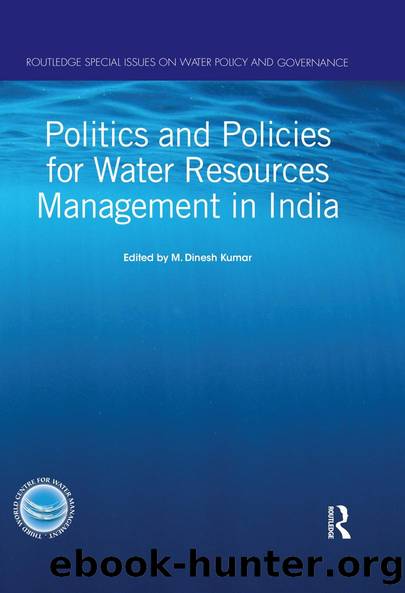Politics and Policies for Water Resources Management in India by M. Dinesh Kumar

Author:M. Dinesh Kumar [Kumar, M. Dinesh]
Language: eng
Format: epub
ISBN: 9781032091723
Google: xXxmzgEACAAJ
Publisher: Taylor & Francis Group
Published: 2021-06-30T03:51:03+00:00
Who gains from the current system of subsidy delivery, and what is its impact on manufacturer pricing?
The fact that agents seek farmers rather than farmers seeking agents suggests that there are serious problems with the subsidy systemâs operation. Farmers indicated that the primary focus of agent visits was to explain the opportunity for the farmers to obtain high-priced products at low cost and to organize the necessary papers for release of the subsidy from the government. The focus was not on the benefits of using the technology or details about maintenance. The agents often promote the lower-quality drip configurations and suppliers within the government-approved lists. This appears to be because dealer margins are greater on lower-quality but still certified products, since all certified products receive the same subsidy. Farmers often accepted the recommendations, perhaps in part due to lack of information, but also in part due to agentsâ offering faster processing of files and sometimes discounts for the lower-quality choices. Overall, it appeared that the farmer had become a passive participant in the subsidy process, with the agent pushing adoption and making the decisions about product choice and supplier.
If it is true that farmers are less-than-active participants in the subsidy acquisition system, we would also expect to see less-than-enthusiastic use of the products once supplied. Casual observations of the alternative purposes to which drip equipment is put confirmed this. For example, in the villages we visited, we saw drip lines rolled up and hung in trees, turned into webbing for chairs, and made into childrenâs swings. This at least suggests that the primary beneficiaries of drip subsidies may be manufacturers or dealers rather than farmers.
Further evidence that the beneficiaries are not farmers can be found in the prices of subsidy-eligible equipment. To assess the price competitiveness of products sold under the subsidy, one would need to compare the prices of subsidized products with prices of similar products available in the open market. However, such a comparison is constrained by the lack of unsubsidized systems on the market (see below). Nevertheless, we were able to find some comparators for a few components of the drip systems sold under the subsidy scheme. Manufacturers eligible for the subsidy scheme provide an important component of the system, Venturi, at INR 4800â5000 (approximately half the system cost for the smallest farms using wide lateral spacing), while in the open market we were able to find the component for around INR 2400. A filter valued at around INR 11,000 in a manufacturerâs subsidy-eligible system was available at around INR 5000 in the open market. Price differences were similar, less than 50% of the âsubsidizedâ cost, for the few other components we could find. It should be noted that the comparison made here is between wholesale, subsidy-eligible prices and retail, unsubsidized prices, so the apparent discrepancy is probably even greater than these figures indicate. Earlier work by Polak and Sivanapan (1998) also concluded that the subsidy system increased prices, as did the work of Shah and Keller
Download
This site does not store any files on its server. We only index and link to content provided by other sites. Please contact the content providers to delete copyright contents if any and email us, we'll remove relevant links or contents immediately.
Kathy Andrews Collection by Kathy Andrews(11678)
The remains of the day by Kazuo Ishiguro(8748)
Paper Towns by Green John(5024)
Spare by Prince Harry The Duke of Sussex(4996)
The Body: A Guide for Occupants by Bill Bryson(4887)
Industrial Automation from Scratch: A hands-on guide to using sensors, actuators, PLCs, HMIs, and SCADA to automate industrial processes by Olushola Akande(4846)
Machine Learning at Scale with H2O by Gregory Keys | David Whiting(3970)
Be in a Treehouse by Pete Nelson(3876)
Harry Potter and the Goblet Of Fire by J.K. Rowling(3737)
Never by Ken Follett(3704)
Goodbye Paradise(3666)
Into Thin Air by Jon Krakauer(3261)
The Remains of the Day by Kazuo Ishiguro(3254)
The Cellar by Natasha Preston(3219)
The Genius of Japanese Carpentry by Azby Brown(3190)
Fairy Tale by Stephen King(3156)
120 Days of Sodom by Marquis de Sade(3118)
Drawing Shortcuts: Developing Quick Drawing Skills Using Today's Technology by Leggitt Jim(2960)
The Man Who Died Twice by Richard Osman(2955)
